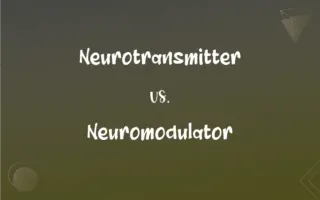AC Generator vs. DC Generator: What's the Difference?
Edited by Janet White || By Harlon Moss || Published on November 19, 2023
AC generator produces alternating current (AC) while DC generator produces direct current (DC).

Key Differences
An AC generator, also known as an alternator, produces an output current that periodically reverses direction. In contrast, a DC generator generates a steady current that flows in a single direction.
The AC generator employs slip rings to maintain continuous contact with the circuit, leading to an alternating output. The DC generator, on the other hand, uses a commutator to reverse the current inside the coil but ensures a unidirectional output.
AC generators are predominantly used for power generation in power plants and are responsible for the electricity used in homes and businesses. DC generators are often found in applications that require a stable and consistent voltage, like battery charging or electroplating.
The output of an AC generator varies sinusoidally, passing through zero and changing polarity. The DC generator, however, aims to produce a consistent and stable output with no polarity changes.
The AC generator became more popular due to the ease of transforming voltages using transformers, making long-distance transmission feasible. The DC generator, while less common today in large-scale power generation, played a pivotal role in early electrical systems and continues to serve specific applications.
ADVERTISEMENT
Comparison Chart
Output Current
Produces alternating current (periodically changes direction).
Produces direct current (flows in one direction).
Main Components
Employs slip rings.
Uses a commutator.
Application Areas
Power plants, general electricity supply.
Battery charging, electroplating.
Output Characteristics
Sinusoidal variation.
Stable and consistent.
Historical Significance
Enabled long-distance power transmission.
Integral in early electrical systems; specific modern applications.
ADVERTISEMENT
AC Generator and DC Generator Definitions
AC Generator
An electrical machine that produces alternating voltage when rotated.
The AC generator's design ensures that the output current periodically reverses direction.
DC Generator
A pivotal component in early electrical systems, now specialized for certain applications.
While not as common as in the past, the DC generator still has essential modern-day uses.
AC Generator
A machine that employs slip rings for continuous electrical contact.
The AC generator's slip rings help maintain its alternating output characteristics.
DC Generator
Often used in applications demanding stable voltage without fluctuations.
The scientist used a DC generator for his sensitive experiments.
AC Generator
A device that transforms mechanical energy into alternating electrical current.
The power plant uses a large AC generator to produce electricity for the city.
DC Generator
An electrical apparatus that generates a steady, unidirectional voltage.
The DC generator in the workshop ensures the tools receive a consistent power supply.
AC Generator
The primary source of alternating current in power generation systems.
Without the AC generator, our homes and businesses wouldn't have the electricity they need.
DC Generator
A machine that converts mechanical energy into direct electrical current.
The old lighthouse used a DC generator to power its lamp.
AC Generator
An alternator designed to produce sinusoidal outputs.
Modern power systems primarily rely on the AC generator for energy production.
DC Generator
A device employing a commutator to produce a direct current output.
The DC generator's commutator is essential for its consistent electrical output.
FAQs
Are AC generators more common in power plants?
Yes, AC generators are predominantly used in power plants for electricity generation.
What type of current does an AC generator produce?
An AC generator produces alternating current.
What is the role of slip rings in an AC generator?
Slip rings in an AC generator maintain continuous electrical contact, leading to an alternating output.
Why might one choose a DC generator over an AC generator for specific tasks?
A DC generator provides a stable and consistent voltage, ideal for applications like battery charging.
How does a DC generator ensure its output remains direct?
A DC generator uses a commutator to maintain a unidirectional output.
What does a commutator do in a DC generator?
A commutator in a DC generator reverses the current inside the coil but ensures a unidirectional output.
How did AC generators impact the power transmission industry?
AC generators made long-distance power transmission feasible due to the ease of transforming voltages.
Is it true that early electrical systems relied more on DC generators?
Yes, early electrical systems did heavily rely on DC generators before the widespread adoption of AC systems.
Is it true that DC generators have less efficiency at partial loads?
Yes, DC generators can be less efficient at partial loads compared to their performance at full load.
Can DC generators be used in automobiles?
Historically, DC generators were used in automobiles, but now alternators (AC generators) are more common due to their advantages.
Can you run a DC device directly off an AC generator?
Not directly. An AC generator's output would need to be rectified to DC to power a DC device.
Can a DC generator power a home?
While possible, DC generators aren't commonly used for home power due to the prevalence and benefits of AC systems.
Which generator is better for long-distance power transmission?
The AC generator is better for long-distance transmission due to the ease of voltage transformation.
Are there portable versions of DC generators?
Yes, there are portable DC generators primarily used for specific tasks and applications.
What role do transformers play with AC generators?
Transformers work with AC generators to step up or step down voltages, aiding in efficient power transmission.
How does a DC generator maintain voltage stability?
Through its design and the use of a commutator, a DC generator ensures a steady and consistent output voltage.
What kind of maintenance does a DC generator require?
DC generators require regular checks on brushes, commutators, and bearings, among other components.
Why are AC generators often called alternators?
AC generators are called alternators because they generate an alternating (changing direction) current.
Why is an AC generator's output sinusoidal?
The AC generator's design, with rotating coils in a magnetic field, naturally produces a sinusoidal output.
Are AC generators larger than DC generators?
The size varies based on application and capacity; AC generators in power plants are typically large, but both types come in various sizes.
About Author
Written by
Harlon MossHarlon is a seasoned quality moderator and accomplished content writer for Difference Wiki. An alumnus of the prestigious University of California, he earned his degree in Computer Science. Leveraging his academic background, Harlon brings a meticulous and informed perspective to his work, ensuring content accuracy and excellence.
Edited by
Janet WhiteJanet White has been an esteemed writer and blogger for Difference Wiki. Holding a Master's degree in Science and Medical Journalism from the prestigious Boston University, she has consistently demonstrated her expertise and passion for her field. When she's not immersed in her work, Janet relishes her time exercising, delving into a good book, and cherishing moments with friends and family.
































































